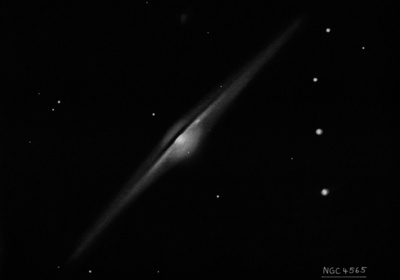Needle Galaxy
Needle Galaxy

William Herschel discovered NGC 4565 = H V-24 = h1357 on 6 Apr 1785 (sweep 393) and recorded "a lucid ray with a vB spot in the middle. The ray about 20' long and about 3 or 4' broad; extended from np to sf, making an angle of about 35° with the meridian. The nebula makes a beautiful appearance." John Herschel made 4 observations and noted the fainter strip on the northeast side of the dust lane. On sweep 407 he recorded "vL; an immensely long ray; pos = 134.5° by micrometer. Both Lord Adare and Mr Hamilton, who viewed it with me, agreed that a feeble parallel band extends below (north) of the nucleus."
R.J. Mitchell, Lord Rosse's assistant on 17 Apr 1855 , remarked "a beautiful object, very well seen in finding eyepiece. The whole neb is much broader (taking into account the appendage) at Nucl than elsewhere, narrowing off suddenly and very symmetrically towards both ends, and the Nucl projects forward into the dark space; and immediately opposide this the faint appendage is broadest and brightest. The ray is 12' or 14' long and there is a faint star at Alpha [on diagram]. (Mr. J. Stoney was with me)"
300/350mm - 13.1" (5/26/84): the absorption lane is prominent at 100x and portion of the galaxy beyond fairly easy. A stellar nucleus is visible within the bright central bulge.
13.1" (5/14/83): fairly bright, very large thin streak, bright core. The dust lane is clearly visible to the north of the bright nucleus.
13.1" (4/24/82): a faint dark lane splits the central bulge into two unequal parts. The nucleus is brightest to the south of the lane. The strip of the galaxy on the north side of the dust lane is fainter.
400/500mm - 17.5" (3/28/87): bright, very large, edge-on 12:1 NW-SE, dimensions approximately 16'x1.5'. A beautiful dark lane is visible continuously with direct vision along most of major axis although more prominent in the center. The galaxy is split asymmetrically by the dust lane with the southern half both larger and brighter. Subtle scalloped structure is visible along the dust lane. Contains a small bright core with a stellar nucleus at the south edge of the lane. A mag 13.5 star is 1.6' NE of the center. A string of five mag 10-12.5 stars of length 11' oriented N-S is west of the galaxy and the southern end leads directly to NGC 4562, 13' SW of center.
900/1200mm - 48" (2/19/12): the view of the dust lane and structure along its edge was remarkable at 287x and 375x. But we spent time exploring the distant galaxy cluster (2.2 billion light years) that resides just off the SE tip and detected 3 or 4 mag 17.7-18 (V) members! Also two nights later, we revisited the cluster and I picked up SDSS J123631.45+255857.2, a mag 17.7V galaxy just 2' SE of the mag 13.5 star NE of the core of NGC 4565.
Notes by Steve Gottlieb